A front end for the home theater.
Much as I am trying to simplify life with one remote, and the L5 Remote for the iPhone makes a huge step forward in fulfilling that goal, I have long been experimenting with a like approach to consolidate the front end for use of my TV.
If, like me, you rip your DVDs to external hard disk drives, then I’m afraid AppleTV or a MacMini running FrontRow do not work. For whatever arcane licensing issues that are involved, neither technology supports the TS/VOB file format resident on a DVD and I’m not about to spend half of my remaining years converting all my movies to a format Apple’s software supports. Further, I like the idea of storing movies in their native format as everything else is a compromise and, who knows, one day maybe 100″ LCD screens will become affordable and that original format will look great, whereas an iPad/ATV version will not. Plus storage is cheap, so I’m not about to start compressing my movies to save on a few bytes of space.
Having tried various front end applications which attempt to deliver all your content through one common interface, I have returned to Plex, one of the few which is written specifically – and only – for the Mac. The app is free and I have it running on my MacMini, attached to the TV. Before explain what Plex can do it is important to point out that it cannot accept encrypted cable company feeds delivered through a set top box, meaning you still have to switch to that input to watch TV. Also, it cannot access the iTunes Store for purchase of movies though there is an app for the Amazon Video On Demand store which is in alpha release. I have tried it and it works well, so it’s a good workaround for those occasions you want to rent or buy a movie rather than wait for Netflix.
Plex’s appearance can be varied using any number of downloadable ‘skins’, and I have opted for the ‘Alaska’ variant in the following snap of the home screen (literally a screenshot as I cannot figure out how to do this otherwise, OS X’s screenshot capability being rendered inoperative by Plex, so pardon the mediocre quality):
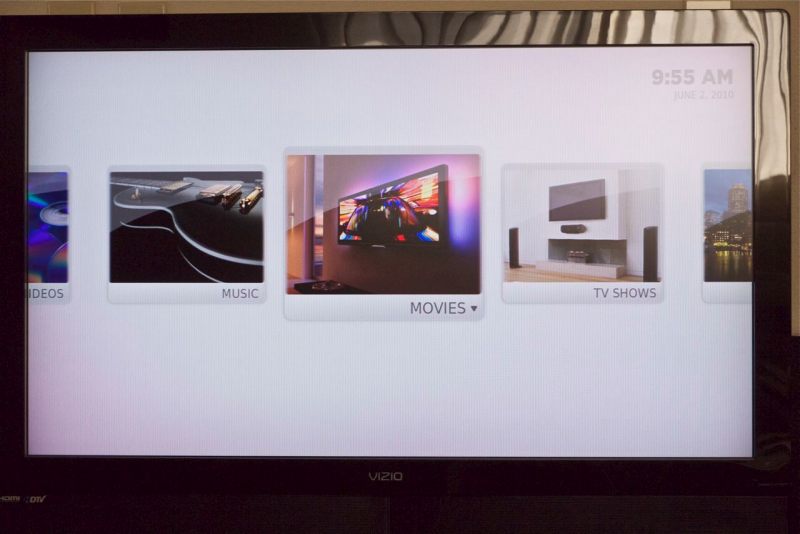
The Plex home screen.
While the L5 Remote folks figure out how to get the Apple Remote’s functions transferred to my iPhone (I have had no luck so far), I am using a downloaded Plex driver for the Apple remote (current aluminum model) which works well with the application. You can also use a wireless mouse which works even better, but neither approach obviates the need for yet one more control device.
My movies are all stored on a bunch of external servers and it is a moment’s work to tell Plex where to find these, using the built in Browse function. Thereafter, Plex can be asked to download movie cover art and synopses, which takes about thirty minutes per hundred movies and is about 80% correct – I had to manually change the remaining 20% as Plex looked up the wrong data. It’s a function of how accurately your movies are named, Plex suggesting that you shoud append the movie’s date in parenteses in the title. The approach I adopted is faster – download and fix the bad ones.

The Movies screen with clickable thumbnails.
Click and hold the Menu button on the Apple Remote and you have the option of looking at the synopsis:
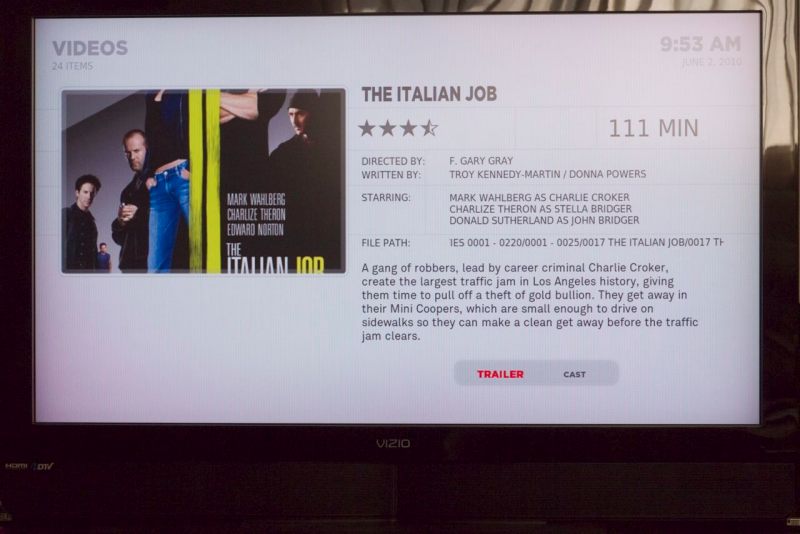
Plot synopsis for a movie.
Movie quality delivered by Plex from locally stored movies is identical to the usual way of playing the movie in VLC or your app of choice.
Switch over to Videos and you can see some of the apps I have downloaded:
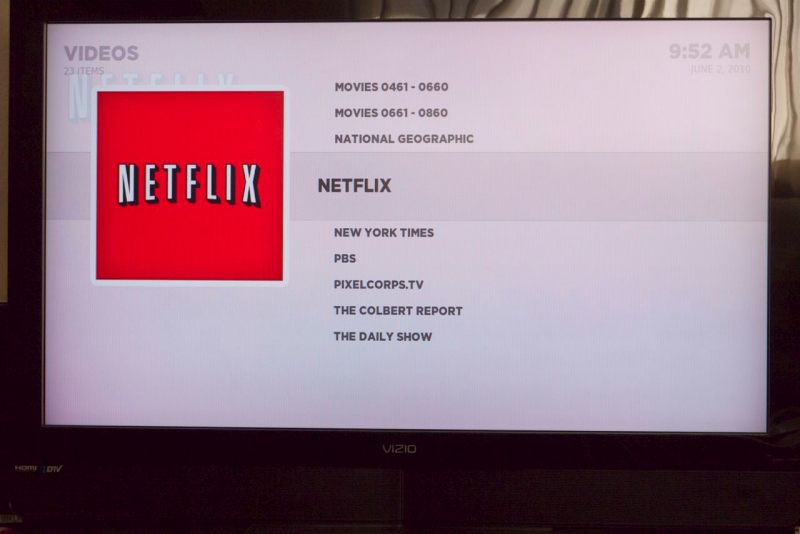
The Netflix streaming movie app is highlighted, two of my local movie file servers appear above.
The Netflix interface is far superior to that delivered by the OS X Netflix app – easier to navigate and easier to use.
Go to Pictures on the Home page and there are several photoblog apps from well known photographers and news media, downloadable through the Plex App Store, all waiting to be displayed in glorious color on your big screen TV:
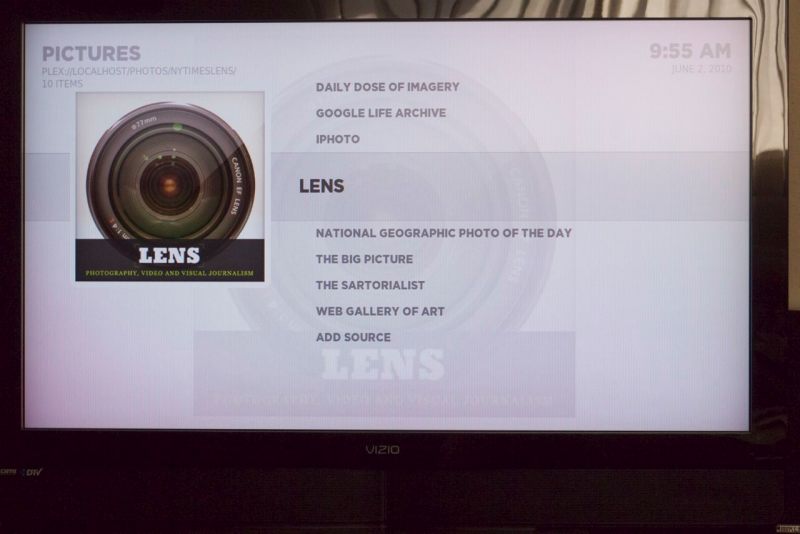
The NYT’s excellent ‘Lens’ app is highlighted.
What’s so exciting about this product is that all content – movies, iTunes, iPhoto, photoblogs, etc. – is delivered through a common interface which is both very responsive and needs the simplest of remotes. The Apple Remote runs all of $19. If you don’t like the look of the interface there are lots of choices out there, including one which emulates AppleTV/Frontrow. I don’t much care for that one but you can almost certainly find something that works.
If you use a Mac to deliver content from multiple local and remote sources to your TV I recommend you take a hard look at Plex. The price is right, as in ‘free’. If your friends use Plex you can even access their libraries using Plex media Server though I have not yet tried that. The next thing I need to do is send a donation to the hard working programming team at Plex, which proves the power of distributed programming, if any proof were needed.
Update on the Apple Remote:
Plex works beautifully with the Apple Remote – either the original white plastic one or the current aluminum version.
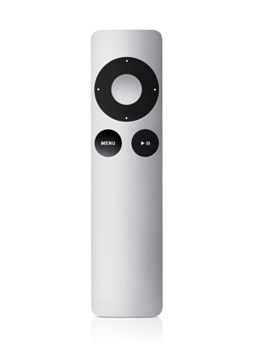
The $19 Apple Remote.
This is a quite extraordinary feat of industrial design. While the down button is too close to the Menu and Pause buttons for those with large hands, the amazing thing about this device is that there is not a seam in sight, the only openings being the battery cover (CR2023) and the plastic cover for the IR emitter. It reminds me of Dr. Who’s spaceship the Tardis, which is famously bigger on the inside than on the outside! How did they get the components in there?
With the downloadable Plex driver the Apple Remote works beautifully with Plex but it argues with my core principle which is to have one remote do everything. So I tried programming the L5 Remote using the Apple Remote but so far without luck. Then it struck me that a Rube Goldberg approach might work so I programmed my RCA Universal Remote in ‘learning’ mode using the Apple Remote, then used the RCA to ‘teach’ the L5 Remote. Success!
I have corresponded with the L5 Remote folks on this (they stated that they have no such problem with the earlier white plastic Apple Remote) and they are looking into the issue once they have their hands on the new aluminum Apple Remote. Clearly it’s unrealistic to expect them to have tried each of the thousands of remotes out there, but the Apple Remote is a special case owing to its likely ownership by a significant percentage of Mac users. I’ll provide details when I have them and meanwhile want to add that my enthusiasm for the L5 Remote remains undimmed, especially given how responsive the manufacturer has been.
Meanwhile I am down to just one remote for everything – the L5!